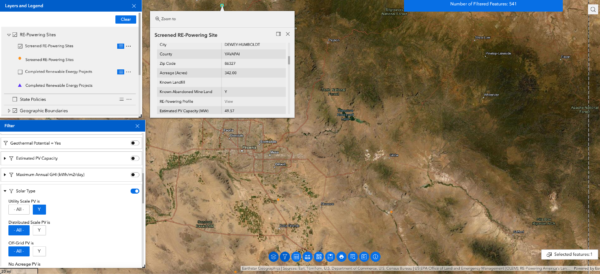The Department of Energy’s Clean Energy Demonstration Office has issued a Request for Information (RFI) to support the development of a renewable energy program on the nation’s 17,750 current and former mines. The goal of the RFI is to choose a selection of projects that will chart a course to guide future projects, as they seek to navigate the long and complex federal, state, and local rules that regulate siting and grid interconnection.
The renewables program – part of the RE-Powering America program – has received $500 million in funding as part of the 2021 Infrastructure Plan. If you’ve got good opinions on how this program should be run, with the program number being DE-FOA-0002811, please register and submit via the link.
The RFI noted a recently launched Environmental Protection Agency tool, the Repowering Mapper, to share screened sites with renewable potential. The tool has a collection of 43,476 sites from the EPA, including Superfunds and Brownfields, as well as 147,500 sites across twenty two state programs. 60 GW of landfill solar potential is also on the list.

The tool suggests that across all sites, mines and non-mine sites, there are hundreds of gigawatts of “technical” solar possibility. The document describing the tool says that these technical maximum potentials are based on land availability, not on items such as market conditions, interconnection capacity, or state programs.
For example:
- 158,171 sites have a Renewable Portfolio Standard
- 70,811 sites have a policy encouraging renewables on contaminated land
- 33,910 sites are near a local community solar program
- 18,928 sites are landfills
The filter tool allows users to specify the type and location of solar projects, and includes more specific information about each of the individual sites. Filters allow users to determine the distance from each site to the nearest roads, railways, transmission lines and substations, as well as the voltages of said electrical gear.

When filtering for mines, the online tool suggests that as many as 541 utility scale (>5 MW) solar facilities could be built, as well as 7,182 distributed (<5MW) systems. The size of the potential systems range from small rooftops systems to large scale ground mounts of hundreds of acres.
The EPA’s Repowering Mapper factsheet noted that the Elizabeth Mine Superfund Solar Project has been a success of the solar mining program. The project was built on a site with ongoing mining since the 1800s, which had polluted water sources above and below ground.
The 7 MW facility, completed in 2017 using approximately 20,000 individual 350 watt Hyundai solar modules, cost $65 million to construct and is located on 45 acres of land. The higher than average priced facility included 10 miles of fiber optic cable to allow the utility to control the system remotely, an upgrade of four miles of utility power lines, and an upgrade to the regional substation.
The mine has ongoing monitoring and cleaning activities shared via the website of the local town of Strafford.
This content is protected by copyright and may not be reused. If you want to cooperate with us and would like to reuse some of our content, please contact: editors@pv-magazine.com.








By submitting this form you agree to pv magazine using your data for the purposes of publishing your comment.
Your personal data will only be disclosed or otherwise transmitted to third parties for the purposes of spam filtering or if this is necessary for technical maintenance of the website. Any other transfer to third parties will not take place unless this is justified on the basis of applicable data protection regulations or if pv magazine is legally obliged to do so.
You may revoke this consent at any time with effect for the future, in which case your personal data will be deleted immediately. Otherwise, your data will be deleted if pv magazine has processed your request or the purpose of data storage is fulfilled.
Further information on data privacy can be found in our Data Protection Policy.